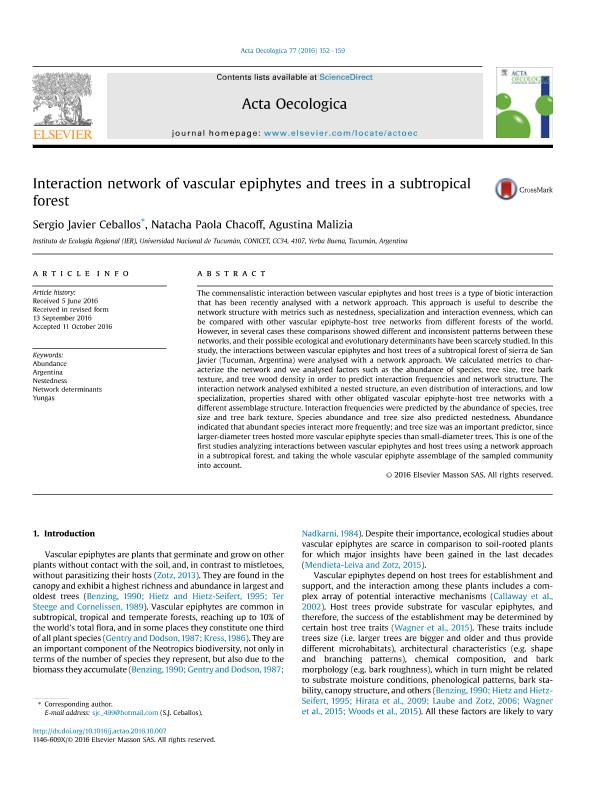Mostrar el registro sencillo del ítem
dc.contributor.author
Ceballos, Sergio Javier

dc.contributor.author
Chacoff, Natacha Paola

dc.contributor.author
Malizia, Agustina

dc.date.available
2018-08-15T18:35:44Z
dc.date.issued
2016-11
dc.identifier.citation
Ceballos, Sergio Javier; Chacoff, Natacha Paola; Malizia, Agustina; Interaction network of vascular epiphytes and trees in a subtropical forest; Gauthier-Villars/Editions Elsevier; Acta Oecologica; 77; 11-2016; 152-159
dc.identifier.issn
1146-609X
dc.identifier.uri
http://hdl.handle.net/11336/55691
dc.description.abstract
The commensalistic interaction between vascular epiphytes and host trees is a type of biotic interaction that has been recently analysed with a network approach. This approach is useful to describe the network structure with metrics such as nestedness, specialization and interaction evenness, which can be compared with other vascular epiphyte-host tree networks from different forests of the world. However, in several cases these comparisons showed different and inconsistent patterns between these networks, and their possible ecological and evolutionary determinants have been scarcely studied. In this study, the interactions between vascular epiphytes and host trees of a subtropical forest of sierra de San Javier (Tucuman, Argentina) were analysed with a network approach. We calculated metrics to characterize the network and we analysed factors such as the abundance of species, tree size, tree bark texture, and tree wood density in order to predict interaction frequencies and network structure. The interaction network analysed exhibited a nested structure, an even distribution of interactions, and low specialization, properties shared with other obligated vascular epiphyte-host tree networks with a different assemblage structure. Interaction frequencies were predicted by the abundance of species, tree size and tree bark texture. Species abundance and tree size also predicted nestedness. Abundance indicated that abundant species interact more frequently; and tree size was an important predictor, since larger-diameter trees hosted more vascular epiphyte species than small-diameter trees. This is one of the first studies analyzing interactions between vascular epiphytes and host trees using a network approach in a subtropical forest, and taking the whole vascular epiphyte assemblage of the sampled community into account.
dc.format
application/pdf
dc.language.iso
eng
dc.publisher
Gauthier-Villars/Editions Elsevier

dc.rights
info:eu-repo/semantics/openAccess
dc.rights.uri
https://creativecommons.org/licenses/by-nc-sa/2.5/ar/
dc.subject
Abundance
dc.subject
Argentina
dc.subject
Nestedness
dc.subject
Network Determinants
dc.subject
Yungas
dc.subject.classification
Otras Ciencias Biológicas

dc.subject.classification
Ciencias Biológicas

dc.subject.classification
CIENCIAS NATURALES Y EXACTAS

dc.title
Interaction network of vascular epiphytes and trees in a subtropical forest
dc.type
info:eu-repo/semantics/article
dc.type
info:ar-repo/semantics/artículo
dc.type
info:eu-repo/semantics/publishedVersion
dc.date.updated
2018-08-15T14:21:57Z
dc.journal.volume
77
dc.journal.pagination
152-159
dc.journal.pais
Francia

dc.journal.ciudad
paris
dc.description.fil
Fil: Ceballos, Sergio Javier. Universidad Nacional de Tucumán. Instituto de Ecología Regional. Consejo Nacional de Investigaciones Científicas y Técnicas. Centro Científico Tecnológico Conicet - Tucumán. Instituto de Ecología Regional; Argentina
dc.description.fil
Fil: Chacoff, Natacha Paola. Universidad Nacional de Tucumán. Instituto de Ecología Regional. Consejo Nacional de Investigaciones Científicas y Técnicas. Centro Científico Tecnológico Conicet - Tucumán. Instituto de Ecología Regional; Argentina
dc.description.fil
Fil: Malizia, Agustina. Universidad Nacional de Tucumán. Instituto de Ecología Regional. Consejo Nacional de Investigaciones Científicas y Técnicas. Centro Científico Tecnológico Conicet - Tucumán. Instituto de Ecología Regional; Argentina
dc.journal.title
Acta Oecologica

dc.relation.alternativeid
info:eu-repo/semantics/altIdentifier/doi/https://dx.doi.org/10.1016/j.actao.2016.10.007
dc.relation.alternativeid
info:eu-repo/semantics/altIdentifier/url/https://www.sciencedirect.com/science/article/pii/S1146609X16300790
Archivos asociados
